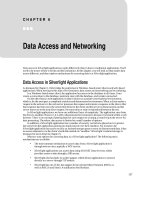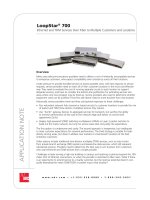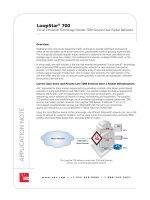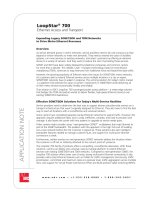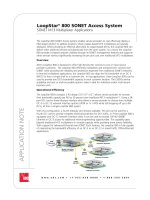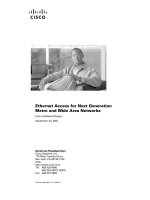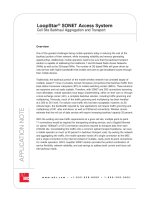LoopStar® 700 Ethernet Access and Transport
Bạn đang xem bản rút gọn của tài liệu. Xem và tải ngay bản đầy đủ của tài liệu tại đây (230.89 KB, 4 trang )
ApplicAtion note
w w w . a d c . c o m • + 1 - 9 5 2 - 9 3 8 - 8 0 8 0 • 1 - 8 0 0 - 3 6 6 - 3 8 9 1
LoopStar
®
700
Ethernet Access and Transport
Expanding Legacy SONET/SDH and TDM Networks
to Drive Metro Ethernet Revenues
Overview
As service demand grows in metro networks, service providers need to be cost-conscious as they
expand or evolve networks to meet new demands. They need to extend the value of installed
systems, run more services on existing networks, and retain customers by offering on-demand
access to a variety of services. And they want to reduce the cost of providing those services.
SONET and SDH have been widely deployed by telephone companies and common carriers
for more than a decade. This reliable, Layer 1 transport technology, based on time-division
multiplexing (TDM), continues to reap revenues from traditional voice and leased-line data traffic.
However, the growing popularity of Ethernet raises new issues for SONET/SDH metro networks.
As customers seek to extend Ethernet services across multiple locations in a city or region,
SONET/SDH networks have to adapt in response. The winning solution for today’s metro market
is a platform that extends the value of carriers’ investments in SONET/SDH while delivering all
of their metro services economically, flexibly and reliably.
That solution is ADC’s LoopStar 700 converged packet access platform – a metro edge solution
that bridges the TDM and packet worlds to deliver flexible, high-speed Ethernet services over
existing SONET/SDH backbones.
Effective SONET/SDH Solutions for Today’s Multi-Service Realities
Service providers need to determine the best way to support diverse subscriber-side services on a
transport infrastructure that wasn’t originally designed for Ethernet. They also have to find the best
way to reach all locations with a cost-effective and universal solution.
Some carriers have considered separate overlay Ethernet networks for packet traffic. However, this
approach requires additional fibers and is costly, inefficient, complex, and hard to provision and
manage. It also leaves the carrier with two systems to upgrade as service needs grow.
Other carriers might consider using “next-generation SONET” multiplexers that map Ethernet to
part of the SONET bandwidth. The problem with this approach is the high first-cost of building
out a new network before the first customer is signed up. These solutions also lack intelligent
bandwidth features needed to manage customer SLAs, and support for multi-point Ethernet
connections is weak.
Furthermore, neither overlay nor next-generation SONET networks address the situation where
the customer is off-net or indirectly attached to the carrier’s point-of- presence.
The LoopStar 700 family of products offers a compelling, cost-effective alternative. With these
solutions, carriers can deploy one universal, easy-to-manage platform to extend Ethernet
services over existing SONET/SDH and TDM networks. Compared to next-generation SONET, the
LoopStar 700 solution offers lower cost of entry, strong multi-point Ethernet connectivity. It also
provides metro-class Ethernet features such as VLANs for traffic management and security, traffic
prioritization, committed and maximum rates at a granular level, traffic aggregation across multiple
links, and support for Virtual Private LAN Service (VPLS) and Multi-protocol Label Switching (MPLS).
2 / 0 6 • 1 0 2 3 1 7 A E
LoopStar
®
700
2
w w w . a d c . c o m • + 1 - 9 5 2 - 9 3 8 - 8 0 8 0 • 1 - 8 0 0 - 3 6 6 - 3 8 9 1
LoopStar
®
700
Ethernet Access and Transport
Multi-Service Capabilities for Customers on SONET/SDH Rings or Off
ADC’s LoopStar 700 system is optimized for high-density, metropolitan-area networks serving single
enterprise customers, multi-tenant units and campus environments. High-density, NEBS packaging
with front access to interfaces makes the LoopStar 700 simple to install in equipment wiring closets
at customer premise locations.
For an “on-net” building already “lit” with an existing add-drop multiplexer (ADM), LoopStar 700 units
can be attached to the existing ADM using typical interfaces, including NxT1/E1, DS3/E3, OC-3c/STM-4.
On the subscriber side, this solution provides copper and fiber Ethernet interfaces, from 10/100 Mbps
to Gigabit Ethernet.
What if the serving area is a high-rise building or campus, and carrier needs to reach customers beyond
the 100-meter limit of Ethernet connections? What if they are restricted to fiber riser? What if they
want to extend service to a nearby customer, but the revenue potential doesn’t cost-justify extending
the SONET/SDH ring to that location?
The LoopStar 700 is ideally suited for all of these situations. This solution can subtend off another
LoopStar 700 through a fiber or copper riser to extend multi-service capability to all floors in a high-rise
building or all buildings in a campus. This subtending configuration, coupled with a modular interface
architecture, makes it very economical to extend services to small serving areas – and gain early-mover
advantage to promote additional services.
For an “off-net” building not served by an existing ADM, where carriers rely on leased circuits from
an alternative carrier, the LoopStar 700 product family provides significant advantages. It offers the
carrier the ability to match the circuit size to the location’s needs, ranging from NxT1/E1, DS3/E3, and
OCn/STMn. The LoopStar 700 also offers uniform services to multi-location customers who are both
on-net and off-net, and it extends management visibility and provisioning all the way to the remote
customer edge.
In addition, LoopStar 700 products can combine Ethernet traffic with legacy T1/E1 circuit traffic to
further reduce costs. Using a robust and patented circuit emulation capability, this platform packetizes
each T1/E1 circuit and uses sophisticated timing recovering and jitter management techniques to
match quality that would otherwise be provided over separate leased lines. For example, a DS3 can be
provisioned to carry a few T1s for PBX or videoconferencing traffic, and the rest of the bandwidth can
be used for Ethernet services.
The LoopStar 700 provides even more operational and leased line savings for an off-net, multi-tenant
building with many customers – each with unique service bandwidth needs. Instead of terminating
separate access circuits to provide services for each tenant, traffic from multiple customers and services
can be consolidated over a single circuit.
In the central office or hub, a single LoopStar 700 platform can aggregate traffic from multiple remote
LoopStar 700s, on-net or off-net. While other solutions require a central-office counterpart for every
edge device in the field, a single, high-density LoopStar 700 can cost-effectively aggregate many
customer locations. This significantly reduces cost, complexity, and space requirements in the central
office or hub. Alternatively, this product can feed other aggregation switches supporting standard
“packet over” products.
On-net building
Central Office
Class 5
Switch
IP/MPLS
Core
PSTN
Ethernet
TDM
LS
700
Ethernet
TDM
LS
700
Fiber-attached building
LS
700
Metro
SONET/SDH
Network
2 / 0 6 • 1 0 2 3 1 7 A E
LoopStar
®
700
3
w w w . a d c . c o m • + 1 - 9 5 2 - 9 3 8 - 8 0 8 0 • 1 - 8 0 0 - 3 6 6 - 3 8 9 1
LoopStar
®
700
Ethernet Access and Transport
OCn/STM
NxDS3/E3
NxT1/E1
Central Office
Class 5
PSTN
IP/MPLS
Core
TDM
Ethernet
TDM
Ethernet
TDM
Ethernet
Transport System
Ethernet
TDM
OCn/STM
NxDS3/E3
NxT1/E1
Central Office
Class 5
PSTN
IP/MPLS
Core
TDM
Ethernet
TDM
Ethernet
TDM
Ethernet
Transport System
Ethernet
TDM
LS
700
LS
700
LS
700
LS
700
Features and Benefits
The LoopStar 700 platform is designed from the ground-up to support multiple services at the carrier edge,
offering service providers a number of important benefits.
High Performance at Reasonable Cost
The payback period on a LoopStar 700 system deployed today is 12 months or less – even if the carrier only
signs one customer. Once deployed, this versatile edge device offers a compelling solution for bundled services
to customers of all sizes. For further savings, carriers can deploy this platform in whichever configuration is
most cost-effective for their needs: point-to-point, star-hub or multi-point.
LoopStar 700 Management and Provisioning
The LoopStar 700 can be managed in-band via a management virtual LAN (VLAN) or out-band via a
management Ethernet or serial port. The LoopStar 700 technology suite provides the tools necessary to
manage and maintain the multi-service demarcation point.
Broad Range of Solution Sizes
The LoopStar 700 product family offers a strong mix of sizes and entry points – from remote single customer
locations to small and medium facilities, up to central office locations aggregating multiple sites. This platform
is designed to support a large variety of applications, ranging from simple fiber extension, to T1/E1/J1
aggregation, to Ethernet-enabling of SONET/SDH multiplexers, to delivering toll-quality, circuit-emulated
voice traffic across a packet-based IP/MPLS infrastructure.
Flexible, Scalable Interfaces
The LoopStar 700 family supports a flexible mix of scalable interface modules. The LoopStar 750, a four-slot,
NEBS3-certified chassis for large customers, multi-tenant buildings or services aggregation locations, accepts any
mix of subscriber-side and network-side interface modules. The LoopStar 722, which uses the same software
base and feature set as the LoopStar 750, offers a combination of fixed configurations and a single interface
module for medium to large customers. The LoopStar 745 offers Ethernet and LoopStar 745P offers Ethernet
and a T1 circuit emulation port to the subscriber, as well as a DS3 uplink to the network. The LoopStar 714 and
LoopStar 718 offer Ethernet over T1s or E1s bonded together with Multilink Point-to-Point Protocol (MLPPP).
Network or Subscriber Interfaces
Gigabit Ethernet, 100 Base-FX Ethernet, 10/100 Base-T Ethernet, OC-12c/STM-4, OC-3c/STM-1, DS3/E3,
NxT1/E1 and (TDM) NxT1/E1
Support for Business-Class Metro Ethernet Services These full-featured edge platforms deliver the rich set of
metro Ethernet services that carriers and their customers require. For example:
ApplicAtion note
Web Site: www.adc.com
From North America, Call Toll Free: 1-800-366-3891 • Outside of North America: +1-952-938-8080
Fax: +1-952-917-3237 • For a listing of ADC’s global sales office locations, please refer to our web site.
ADC Telecommunications, Inc., P.O. Box 1101, Minneapolis, Minnesota USA 55440-1101
Specifications published here are current as of the date of publication of this document. Because we are continuously
improving our products, ADC reserves the right to change specifications without prior notice. At any time, you may
verify product specifications by contacting our headquarters office in Minneapolis. ADC Telecommunications, Inc.
views its patent portfolio as an important corporate asset and vigorously enforces its patents. Products orfeatures
contained herein may be covered by one or more U.S. or foreign patents. An Equal Opportunity Employer
102317AE 2/06 Original © 2006 ADC Telecommunications, Inc. All Rights Reserved
•
Virtual LAN (VLAN) processing (tagging, swapping or stacking), based on IEEE 802.1Q standards,
segregates customer or departmental traffic for security, traffic management and differentiated treatment.
•
Seven levels of priority can be established using 802.1P priority bits, with circuit-emulation traffic always
allocated highest priority.
•
Rate limiting (setting committed rate and maximum burst rate) can be configured by port or by VLAN at
fine granularities: 1 Mbps increments for 1-100 Mbps, and 50 Mbps increments for 100-100 Mbps.
•
Link aggregation improves resiliency and throughput by combining up to eight links (same or different
types) into one logical link, load-balancing traffic among links, and redirecting traffic to an active link
if another link in the group fails.
Support for Carrier-Class Circuit Emulation Services
The LoopStar 700 also delivers traditional T1 (E1 or J1) circuit-based voice/data/video services over Ethernet/IP
with the same “No Compromise” quality and robustness as a circuit delivered in native TDM or SONET/SDH.
The LoopStar 700 uses patented technology to resolve the difficult issues of preserving timing across packet
networks, transparently handling delays and other packet impairments, and passing traffic through other
switches and routers in the typical multi-vendor network
Flexible Bandwidth Allocation
Any combination of Ethernet and TDM bandwidth can be supported, up to the payload rate of the uplink. For
example, suppose the uplink is a DS3. Rather than divide that DS3 into DS1s, and then inverse multiplex four
or eight of them to form a 6 or 12 Mbps data channel, the carrier can allocate Ethernet bandwidth in 1 Mbps
increments. The carrier provides 1 Mbps Internet access to a customer, and when more bandwidth is required,
the connection can be bumped to 2 Mbps, or 11 Mbps or 35 Mbps, without ever having to physically change
the interface. When bandwidth requirements exceed a single DS3, other DS3(s) can be seamlessly added to
support greater speeds.
Future-Ready, Programmable Architecture
Programmable processors in the LoopStar 700 platform outperform software-based routing engines and offer
more flexibility than ASICs. With this network- processor architecture, the LoopStar 700 products can be
programmed to support new protocols, interfaces and features as they emerge – enabling network evolution
without forklift upgrades.
Intelligent Evolution Strategy
As bandwidth needs grow, the LoopStar 700 can be transitioned from a SONET/SDH ring attachment
to a Gigabit Ethernet or DWDM solution simply by changing out a card. Both the carrier and end user
preserve their existing investment and migrate to the next-generation networks on a timetable that
makes business sense.
Summary
ADC’s LoopStar 700 is a low-cost, compact, next-generation access network solution that enables the cost-effective
delivery of Ethernet business services. The benefits of this solution include bandwidth efficiency to minimize
transport costs and Ethernet service functionality to meet service providers’ requirements for class-of-service SLA
flexibility. In addition, the LoopStar 700 aggregates TDM and Ethernet for simultaneous deployment of both legacy
and new packet-based services.
